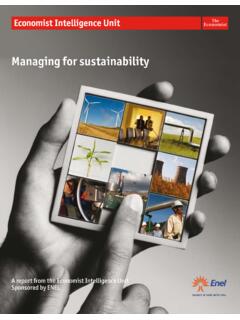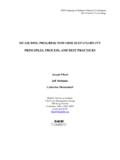Transcription of Measuring Progress Over Time: The Sustainability Cultural ...
1 Measuring Progress Over Time: TheSustainability Cultural IndicatorsProgram at the University of MichiganJohn Callewaert and Robert W. MaransAbstractThe Sustainability Cultural Indicators Program (SCIP) is a multi-year projectdesigned to measure and track theculture of sustainabilityat the University ofMichigan. It is intended to inform U-M administrators and others responsible forday-to-day operations of the University including its academic , it is intended to serve as a model demonstrating how behavioralresearch can be used to address critical environmental issues within universitiesgenerally and in other organizational settings. Culture of Sustainability is meantto reflect a set of attitudes, behaviors, levels of understanding and commitment,degrees of engagement, and dispositions among a population such as membersof a university community.
2 This paper presentsfindings from three years of datacollection (2012 2014) focusing on trends in responses from over 17,000students, faculty, and staff. One of the most positivefindings is that respondentsreport increasing levels of Sustainability knowledge over time. However, SCIP results indicate that there is considerable room for improvement with regard topro-environment behavior, engagement, and expressed commitment to sustain-ability. Finally, a brief overview is provided of how SCIP results are being usedby multiple units on campus to guide programming and how SCIP is informingefforts at other Callewaert (&)Graham Sustainability Institute, University of Michigan, 625 E. Liberty,Suite 300, Ann Arbor, MI 48104, USAe-mail: MaransInstitute for Social Research, University of Michigan, 426 Thompson Street,Ann Arbor, MI 48106, USAe-mail: Springer International Publishing AG 2017W.
3 Leal Filho et al. (eds.),Handbook of Theory and Practice of SustainableDevelopment in Higher Education, World Sustainability Series,DOI Sustainability Survey research Cultural indicators1 Campus Sustainability Integrated AssessmentIn October 2009, former University of Michigan (U-M) President Mary SueColeman elevated the University s commitment to Sustainability in teaching,research, operations, and engagement by creating the U-M Environmental Sus-tainability Executive of thefirst actions of the Council was endorsinga Campus Sustainability Integrated Assessment (CSIA) to analyze the U-M ssustainability efforts to date, benchmark against other institutions, and chart acourse for the future through identifying long term goals for sustainable operationson the U-M Ann Arbor campus, including the Athletic Department and the HealthSystem.
4 The CSIA builds on a long history of Sustainability commitments in U-Mcampus operations, such as implementing cogeneration technology at the CentralPower Plant in the 1960s, adopting the EPA Green Lights and Energy Star pro-grams in the 1990s, and more recently establishing LEED (Leadership in Energyand Environmental Design) Silver certification as the standard for new non-clinicalconstruction projects where the construction value exceeds US$ geographic scope of the CSIA spanned thefive Ann Arbor campuses(South, Central, Medical, North and East Medical), which currently includes over 3million square meters of teaching, research, health care, athletics and administrativebuilding space.
5 In 2014, these buildings served more than 80,000 occupants students, faculty and staff (University of Michigan2015). Total campus operationsgenerated over 700,000 metric tons of carbon dioxide emissions (Office of CampusSustainability2014). Additional information on Sustainability at the University ofMichigan can be found on the Planet Blue website the main Sustainability portalfor academic, research, and operations magnitude of U-M campusoperations suggests that aggressive Sustainability goals for University campusoperations could have significantly positive environmental,fiscal, and CSIA report outlines four high level themes Climate Action,WastePrevention,Healthy Environments, andCommunity Awareness.
6 Accompanying the1 The Council is comprised the University President, the Provost and Executive Vice President forStudent Affairs, the Vice Presidents for Research, Student Affairs, Development, and GlobalCommunications & Strategic Initiatives, the Executive Vice President for Medical Affairs, and theExecutive Vice President and Chief Financial Planet Blue website can be found at: Callewaert and Maransthemes are Guiding Principles to direct the U-M s long-range strategy and 2025 Goals that are time-bound and an overview of theU-M s 2025 Sustainability The Sustainability Cultural Indicators ProgramInstitutions of higher education play a pivotal role in addressing the more difficultyet powerful part of the Sustainability transition.
7 That role is in creating andmaintaining a culture of Sustainability among members of the university com-munity. A culture of Sustainability has been defined as a culture in which indi-viduals are aware of major environmental (and social/economic) challenges, arebehaving in sustainable ways, and are committed to a sustainable lifestyle for boththe present and future (Marans et ,2014). To achieve this ideal state withininstitutions of higher education, Sharp (2002) calls for a rethinking of organiza-tional action and actors that questions the prevailing assumptions of organizationalrationality that stays within the confines of the current systems. Similarly, Senge(2000) stresses the importance of cultivating a learning organization, rather than a knowing organization since change at higher education institutions is a complexlearning and unlearning process for all concerned (Scott2004).
8 Therefore, nothingless than a paradigmatic shift in organizational thinking is needed for colleges anduniversities to promote Cultural organizational transformation is needed in all sectors of society. Yetinstitutions of higher education can and should be at the forefront with the col-lective mission of fostering Sustainability through our actions and through culti-vating future Sustainability leaders. To date, however, most campus sustainabilityefforts stop either at greening or at the level of institutional commitments toeco-efficiency, climate and waste mitigation, and increasing environmental educa-tion. Though calls for institutional and Cultural transformation are multiplying at arapid rate, rarely do institutions address the deeper Cultural change necessary totransform into sustainable organizations which empower citizens with a sustain-ability perspective; instead, focus is often on implementing many individual pro-jects, isolated initiatives, or broad commitments (Sharp2002,2009).
9 This is partlyattributable to the lack of guidance for institutions attempting to follow this moreuncertain and uncomfortable path. However, it should be noted that the Associationfor the Advancement of Sustainability in Higher Education is doing much tosupport these efforts through their Sustainability Tracking, Rating & AssessmentSystem (STARS) which is used by hundreds of institutions. The version ofSTARS asks institutions to report on both their Sustainability literacy assessmentefforts and assessing a culture of Sustainability (AASHE2016). In addition the3 More information on the CSIA process, outcomes, and evaluation can be found at: Information on Progress towards the 2025 Climate Action,Waste Prevention, and Healthy Environments goals can be found at: Progress Over Time: The Sustainability of Bartlett and Chase (2004,2013) have done much to chronicle institutionalsustainability transformation Cultural change initiatives stem from the principles outlined under CSIA theme of Community Awareness.
10 They indicate that the U-M will pursue evalu-ation strategies toward a campus-wide ethic of Sustainability as articulated inPresident Coleman s September 2011 speech announcing the Sustainability , she stated that we will scientifically measure and report our progressand behavior as a (Institute for Social Research) researchers willmeasure the Sustainability attitudes and activities of students, faculty and staff, aswell as identify where we can improve. The evaluation strategies involve agroundbreaking program for monitoring the U-M s Progress in moving toward aculture of Sustainability . Progress would be determined by an annual survey ofstudents, faculty and staff regarding Sustainability awareness and behavior andtracking changes over 1 CSIA themes, guiding principles, and 2025 goalsThemeGuiding principle2025 GoalsClimateactionWe will pursue energy efficiencyandfiscally-responsible energysourcing strategies to reducegreenhouse gas emissions towardlong-term carbon neutralityReduce greenhouse gas emissions(scopes 1 and 2)









